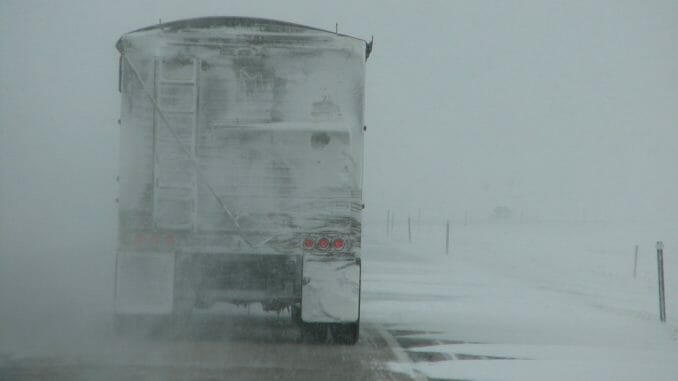
Life on the road is constantly in motion. Day in, day out, every choice and decision is focused on one thing: keeping the freight moving no matter what. Although this desire to keep hauling can earn truckers a lot of money, it can also cause them to risk their own safety.
Being in a dangerous situation, such as driving in bad weather, is not worth dying over. Especially when you have the choice to not keep going. During a trucker’s life on the road, there will times when you have to make a fateful decision – to drive or not to drive.
This is a choice that you alone are responsible for making. And sometimes, more money can be earned by waiting out a storm rather than pushing through it. Let’s take a look at how seasoned drivers have learned how to handle trucker weather issues.
Is Driving Through Bad Weather Worth the Risk?
Over-the-road trucking leads drivers through regions with different types of weather. One area may be hot and humid whereas the next location is freezing cold. These frequent changes from region to region can be unpredictable. Learning to face each weather situation is one of the challenges you will face in your first 100,000 miles.
Over the course of a long-haul truck driving career, drivers face severe thunderstorms, hail storms, high winds, and maybe even tornadoes. Dangerous weather comes in many forms. The most important lesson for new drivers is this: If you don’t feel safe driving, don’t drive.
Your driver manager (DM) or dispatcher does not have a say in your safety. You are the one in the driver’s seat, which gives you the best picture of what is going on. If you don’t feel the conditions are safe, especially in your first year, it’s not worth it to risk it.
Snow and ice are both particularly dangerous. Sure, tire chains can provide an added measure of safety while hauling cargo through the mountains, but they are not guaranteed to keep you on the road. One small mistake can have deadly results.
What About My Trucking Company?
The obvious concern is a big one: You don’t want to get fired.

Throughout a truckers’ life on the road, a frequent concern they face is having to answer to their trucking company.
After all, if the company is displeased with your work ethic, they won’t give you the loads you need to make money. Fortunately, truckers that choose to not push through dangerous weather are not looked down upon.
Professional trucking companies know the risk that comes with over-the-road trucking.
They understand that by pushing through terrible weather they could lose a good trucker and hundreds of thousands of dollars in an instant. This is not a risk that trucking companies take lightly.
Most companies will prefer to reschedule, as inconvenient as that is, rather than lose a valuable employee and precious cargo. They have enough accidents to deal with each year already and want to avoid additional occurrences as much as possible.
If you stop every time the road is wet, you might have a problem. But if there is a legitimate safety concern, your trucking company will understand.
How Do I Determine If I Should Drive?
Making the decision about whether or not to drive can be tough. When is the weather bad enough to stop the truck? What if the storm only lasts a few more minutes? What is level of risk?
These questions can be hard to judge in different weather situations. We have created the following list to help you figure out how to handle each weather situation according to your comfort level:
-
Can you see the road? What about the lines on the road? How about the taillights of the vehicle in front of you?
- If these visual cues are not popping out to you while driving, consider your safety and pull over. Although the road may be fine to drive on, if you can’t see past the end of your hood, it’s time to call it a day.
-
What are the road conditions like?
- Sure, you may be able to see the outline of the road, and the lines dividing the lanes, but if the road is icy, this is a real danger to an 80,000 pound truck. And there might be a good chance that black ice looms just down the road. Black ice is completely clear and won’t be visible to you.
- Icy roads can cause your trailer to fishtail and go off of the road or into other drivers very quickly. If you notice that the road is slick and the temperature is only going to drop, avoid falling into this icy trap.
-
Is your trailer wobbling strongly behind you?
- Swift, high winds can blow around your trailer causing it to crash into something. This fact is especially true if you are driving a dry van or reefer. If you notice that the wind is having an impact on your steering, don’t drive.
In addition to these tips, also consider your pay for the driving time. Say you throw on your tire chains and keep going, but you can only reach a speed of 30 mph. In this situation, you are spending one of your Hours of Service while only covering half the distance. Since you are being paid by the mile, you are getting less money for your time AND putting your life in danger. Due to this, it is very important for you to consider whether or not you want to keep driving.
Check the Weather Forecasts.
Before entering into a new region, over-the-road truck drivers should prepare for the road ahead by checking the weather radar. This can shed some light on what to anticipate and can create a window of time for drivers to prepare for any adverse conditions.
Another useful resource long-haul truck drivers can use is the Federal Highway Administration, or FHWA. They operate a service that is designed to provide updated travel conditions for any state in the country. Just call “511” in any state in the country to access the information.
You can also use your smartphone to check the weather forecast for the next region you are headed for.
Prepare for Different Weather Conditions.
Another requirement for trucking is to pack appropriately for the weather. If you are heading into a cold region up north on your run, or any area that is expecting snowy weather, bring along your winter gear.
Keep warm clothes, jackets, and blankets in your cabin. Bear in mind that you will be sleeping in your truck when it is freezing cold outside.

Other useful equipment includes thick socks, waterproof boots, and gloves. To improve the odds of being able to keep driving through snowy weather pack the following items.
- Ice Scrapers
- Road Salt
- Snow Shovels
- Tire chains
- Diesel Anti-Gel Additive
- Jumper Cables
These can be handy if the falling snow suddenly turns into a nasty blizzard. During such events, you could be snowed in or stuck until the snow melts.
To be prepared, truckers should pack extra non-perishable food and a few gallon jugs of water. Above all else, don’t panic. Staying calm and rational can help you endure being stranded. Using a level head, you can safely navigate through bad weather and continue your over-the-road trucking career for years to come.
